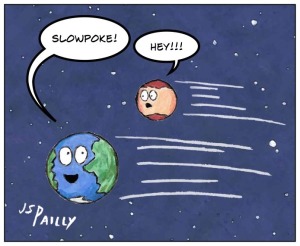So you’re planning a vacation on Mars and want to know when is the best time to go. This may seem counterintuitive, but you might want to schedule your launch for when Earth and Mars are on opposite sides of the Sun. This is known as a conjunction-class mission.
Keep in mind that any journey to Mars will take months. During that time, the planets will move around in their orbits, with Earth moving slightly faster than Mars (66,000 m.p.h. versus 54,000 m.p.h.). Earth’s orbit is also smaller than Mars’s, so if the two planets were racing, Earth would be lapping Mars on the racetrack quite frequently.
In conjunction-class missions, Mars may be on the far side of the Sun at launch, but your spacecraft takes full advantage of Earth’s greater momentum and soon catches up. This gives conjunction-class missions certain benefits over the alternative opposition-class missions (which we covered on Monday):
- You need a lot less fuel.
- You get to spend a lot more time on Mars—almost two years! For this reason, conjunction-class missions are also known as long-stay missions.
- Unlike in opposition-class missions, you don’t have to cut through the Inner Solar System on your way home to Earth. This makes conjunction-class missions far less complicated and, at least on the return leg of your voyage, safer.
The only real downside is that your journey to and from Mars will take longer. Although spending more time in space does raise a few health and safety concerns, almost every serious plan for the long-term exploration and colonization of Mars seems to favor conjunction-class missions.
Personally, if I were going on a Martian vacation, I’d choose a conjunction-class flight. The lower fuel requirements mean lower ticket prices. Having more time to go sightseeing on Mars is an added bonus. I just have to convince my day job to let me take a two-year vacation.
So how would travel to Mars? Would you prefer the faster, marginally safer opposition-class flight or the longer, less expensive conjunction-class?
P.S.: If you want to learn more about opposition- and conjunction-class missions to Mars or about humanity’s future on Mars in general, I highly recommend The Case for Mars by Robert Zubrin. The book lays out the most believable and compelling plan for the exploration and eventual colonization of Mars I’ve ever seen.
* * *
Today’s post is part of Mars month for the 2015 Mission to the Solar System.

I read a while back that there was research being done for a trip using a VASIMIR drive, which might be doable for an opposition launch. From what I remember, the outbound trip might be as short as 6 weeks.
The problems with a conjunction launch seem to keep mounting (radiation, effects of prolonged zero-g, necessary supplies, etc). I suspect for humans to make the trip, we’re going to have to find a way for an opposition trip.
LikeLiked by 1 person
I’ve heard of VASIMR, but I was under the impression that it’s a long, long way from being able to get us to Mars. Six weeks would definitely make my vacation plans more feasible.
LikeLike
VASIMR can’t be used for the initial launch, trans Mars injection, lifting off of Mars, etc, but it’s a long running low thrust solution that could run continuously during the transit, supposedly shortening it to 39 days.
http://news.discovery.com/space/private-spaceflight/mars-rocket-vasimr-nasa.htm
No idea if there’s any specific time frame for it yet.
LikeLiked by 1 person
The establishment of a Mars colony is almost certainly an exciting prospect if it weren’t for the recent probes which have yielded little in terms of sustaining life. Still Mars is real with volcanoes dwarfing Earths highest peaks. Who knows what secrets lie buried within the red planet. Tell you what, sign me up for a conjunction class ticket. I’m good to go.
LikeLike
PS – I nominated you as a creative blogger passing the happy vibes around. I hope you don’t mind. I posted more details in my most recent blog post.
LikeLike
I don’t mind at all! I love happy vibes. Do I have to post my acceptance on a specific date, or can I wait until Mars month is complete?
LikeLike